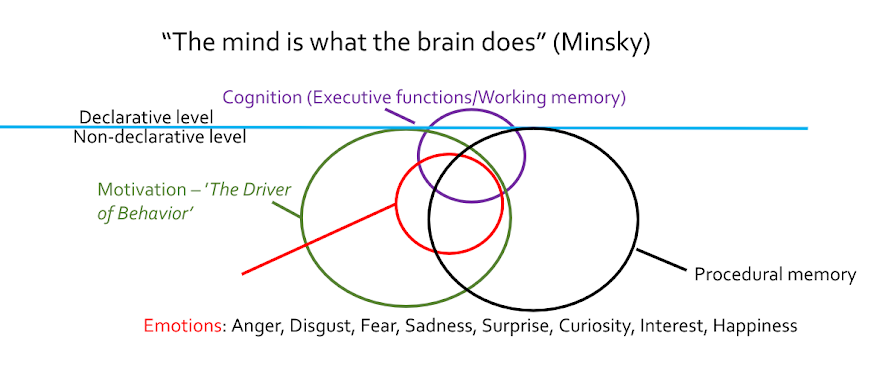Please support the blog via Swish (Sweden), MobilePay (Finland) or Wise.
Humans are the only creature who has a language – expressions of our thoughts through visual and auditory images, as well as abstract propositions – which we use to send information from one mind to other minds (Pinker, 2010).
After our ancestors' brains had expanded significantly, from the occipedal lobe and forward (Aiello och Dunbar, 1993; Aiello och Wheeler, 1995; Coolidge and Wynn, 2018; Hublin et al. 2014: Pontzer et al 2016), and our genus was established (Kimbel och Villmoare, 2016; Villmoare, 2018; Villmoare et al. 2015), they started to use a cultural pragmatic language. Over a long period of time, a grammatical structure emerged (Aiello and Dunbar, 1993; Ardonetti, 2016; Everett, 2017; Pagel, 2017).
Language is created in a generative process based on phonetics, syntax, semantics, and pragmatics (Tomasello, 2003). That means that new words and expressions are continuously created. As part of that generative process, proverbs (adages) emerged across the globe.
“A proverb (from Latin: proverbium) or an adage is a simple, traditional saying that expresses a perceived truth based on common sense or experience. Proverbs are often metaphorical and are an example of formulaic language” (Wikipedia).
“A proverb is a short, generally known sentence of the folk which contains wisdom, truth, morals, and traditional views in a metaphorical, fixed, and memorizable form and which is handed down from generation to generation” (Mieder, 1993).
“Proverbs are indeed a rich manifestation of a society's values, beliefs, and worldview and serve valuable didactic and communicative purposes. However, they also project stereotypes and ideologies which often go unnoticed” (Lomotey and Csajbok-Twerefou, 2021).Proverbs are discriminated against:
- idioms – a group of words in a fixed order that has a particular meaning that is different from the meanings of each word on its own, that is, phrases or expressions that largely or exclusively carries a figurative or nonliteral meaning.
- cliches – phrases, remarks, or opinions that has very often been said or expressed before and is therefore not original and not interesting.
“Linguistic anthropology is the interdisciplinary study of how language influences social life” (Wikipedia).
“Sociolinguistics is the descriptive study of the effect of any or all aspects of society, including cultural norms, expectations, and context, on language and the ways it is used” (Wikipedia).
“In linguistics and related fields, pragmatics is the study of how context contributes to meaning” (Wikipedia).
“In cognitive semantic terms, the proverb is one of the modes of conceptualizing the world and human experience” (Načisčione, 2022).Proverbs probably emerged as a tool for learning; by constructing contextual phrases, the likelihood of many people remembering them and that symbolic convergence (Broddman, 1985) and common knowlegde (Thomas et al. 2014) should be established likely increased.
Understanding a proverb is different from being able to create them, and do not require specialized abstract thinking:
“The widely held idea that failure to provide a figurative interpretation of a proverb necessarily reflects a deficit in specialized abstract thinking is rejected. Moreover, the ability to correctly explain what a proverb means does not necessarily imply that an individual can think abstractly. Various empirical evidence, nonetheless, suggests that the ability to understand many proverbs reveals the presence of metaphorical schemes that are ubiquitous in everyday thought” (Gibbs and Beitel, 1995).This is consistent with research on declarative versus non-declarative memories, which suggest that people who are good at something, are worse at describing that skill and vice versa (Berry and Broadbent, 1984; Broadbent, FitzGerald, and Broadbent, 1986). Hence, proverbs probably predates recorded history, which dates ~6000 years before the present.
Conclusion. Language emerged for the purpose of sending information from one mind to other minds. Language is a generative process based on phonetics, syntax, semantics, and pragmatics. Proverbs are rather pragmatic expressions. The ability to form proverbs are discriminated against the ability to understand them and vice versa.
Please support the blog via Swish (Sweden), MobilePay (Finland) or Wise.
More about my expertise:
Executive coaching for CEOs/managers and workshops to facilitate Organizational Performance, Learning, and Creativity for Problem Solving | Lectures: Nutrition for physical and mental health | Course/lecture: children's emotional and social adjustment and cognitive development | Language training - Swedish | Academy Competency | CV | Teaching skills and experience | Summary of research project | Instagram | Linkedin | YouTube-channel | TikTok | Twitter

No comments:
Post a Comment